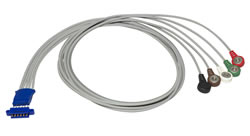Meeting Medical Industry Standards for Cable Design
With no medical industry standards for cable, the industry adopts voluntary specifications to ensure patient safety.
 The medical device industry tolerates a much smaller margin of error than most other industries. Medical devices are highly precise and sensitive instruments. As such, medical interconnect cable, and more significantly, the material used in such apparatuses, must be carefully chosen to perform under a unique set of circumstances that standard, off-the-shelf cable products often can’t withstand. Therefore, the design of medical interconnect cables is a specialized science that requires specific engineering expertise. This expertise ensures that development and fabrication of such interconnect devices meets exacting standards, often under less than ideal conditions.
The medical device industry tolerates a much smaller margin of error than most other industries. Medical devices are highly precise and sensitive instruments. As such, medical interconnect cable, and more significantly, the material used in such apparatuses, must be carefully chosen to perform under a unique set of circumstances that standard, off-the-shelf cable products often can’t withstand. Therefore, the design of medical interconnect cables is a specialized science that requires specific engineering expertise. This expertise ensures that development and fabrication of such interconnect devices meets exacting standards, often under less than ideal conditions.
Cable Manufacturing
Design criteria for medical cables dictate that, in most cases, common cable manufacturing methods cannot be used, or at the very least, need to be modified. The packaging and medical manufacturing industries are heavily regulated and must maintain a high level of hygiene to prevent end users from being exposed to harmful microorganisms. The standard ANSI/AAMI EC53, for example, was developed to address electrocardiogram (ECG) cables and leads. While it only applies to ECG cables, it is often used as a base upon which to build specifications for other medical cable applications, since there is no global medical cable standard.
The ANSI/AAMI EC53 attempts to ensure a level of reliability and safety for cable specifications. Originally, it was developed to prevent the inadvertent cross-connect of patient leads to eliminate the potential of the leads coming in contact with a power source. An additional corollary facilitates patient movement in situations where time is of the essence, so cable management is not an issue in transport or transfer. While the standard is voluntary, most reputable cable manufacturers will use it as a formal standard as an avenue to meet FDA qualification requirements.
The standard covers electrical, mechanical, testing, and environmental concerns.
Electrical Issues in Medical Cable Design
In general, accepted practices of electrical source isolation are required. This is a bit of a moving target, since defibrillation applies high levels of voltage to the patient through its cables, while monitors for heart rate, pulse, and other vital signs do not. Depending on the customer’s application, isolation design can be critical to protect both the patient and the monitoring equipment.
Another primary goal of this section of the standard is to ensure that an adequate level of shielding is designed in, to minimize or eliminate the various noise sources. The standard establishes the maximum peak-to-peak noise of 50 µV and a standard test method to confirm the noise levels. Other electrical requirements such as hi-pot, sink current, and contact resistance are detailed as well.
Mechanical Issues in Medical Cable Design
The mechanical section of the standard includes elements that relate to stress, force, flexibility, and tensile strength. Typical parameters include numbers of mate/un-mate cycles, pull/retention forces, and flex cycles, generally for contacts and connectors that are cable intermates. In each case, the designer should know the specifics for the application and use the standards accordingly.
Testing Issues in Medical Cable Design
Testing cable involves a wide variety of parameters, from electrical to physical to functional, but here we focus on the electrical.
Because medical cables’ currents can span the gamut from a few micro amps to several amps, it would be unwieldy at best and unrealistically complex at worst if the standard were to attempt to address each scenario. Therefore, rather than address each situation specifically, the standard attempts to establish procedures rather than methodology that can be applied to most cables with respect to their applications. Such a test standard gives the engineer a level playing field when designing to the customer’s requirements. Test equipment, circuits, and specific procedures are detailed and allow uniform and consistent testing, while the test standard provides test methods and procedures by which compliance to the standard can be verified.
Environmental Issues for Medical Cable Design
Cleaning and sterilization are paramount in bio-medical environments. The standard lays out a set of procedures so the engineer can design cable components to withstand the harsh chemicals, extreme environments, and procedures that will ensure patient safety. For example, the standard stipulates that cables must withstand being cleaned 15 times using green soap, glutaraldehyde, or bleach. Depending on the environment and device usage, sterilization methods may include steam autoclave, EtO, or E-beam sterilization. However, in other environments, a simple wipe may be the sterilization method of choice, such as a wipedown with high-concentration chlorine (generally in a pre-packaged wipe form, such as Clorox Dispatch wipes) or Isopropyl alcohol 70% concentration. These types of products may need to be considered in the design of the cable as well. The choice of sterilization method must be identified in the early design stages of the device when materials are selected and life cycles are calculated. The final application determines actual environmental design requirements; however, the adherence to a specification ensures that the cable will be capable of withstanding the sterilization method necessary for the end user.
This article is an excerpt from a white paper by Bioconnect’s Floyd Henry, entitled “Cable Material Design Criteria for the Medical Industry.” You can read the white paper in its entirety here or visit Bioconnect online.
[hr]
 Floyd Henry is director of manufacturing and engineering for Bioconnect, a division of RF Industries. He is responsible for component, mold tool, and manufacturing process design, as well as wire and material selection. Henry has been with Bioconnect for 18 years and has an educational background in physics and physical science.
Floyd Henry is director of manufacturing and engineering for Bioconnect, a division of RF Industries. He is responsible for component, mold tool, and manufacturing process design, as well as wire and material selection. Henry has been with Bioconnect for 18 years and has an educational background in physics and physical science.





